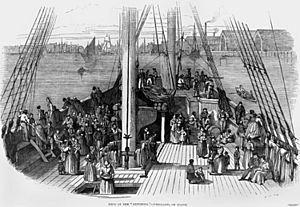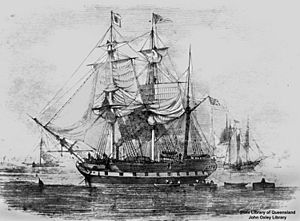Artemisia (ship) facts for kids
The Artemisia was a special ship. It was the first ship to bring free settlers from England to Moreton Bay. This happened in December 1848. The ship was built in Sunderland in 1847. It was a type of sailing ship called a barquentine. The Artemisia weighed 492 tons (about 558 tonnes). Its owner was A. Ridley, and Captain John Prest Ridley was its master.
Contents
Why People Moved to Moreton Bay
The Need for New Settlers
The Moreton Bay area was first set up in 1824. It was a place where convicts from New South Wales and Van Diemen's Land were sent. But in 1842, it was opened for free people to live there.
By 1846, many people lived in towns like North Brisbane, South Brisbane, and Ipswich. However, there was a big shortage of workers. They needed manual workers, shepherds, tradesmen, and house helpers.
John Dunmore Lang's Idea
A man named Reverend Dr. John Dunmore Lang wanted to help. He had brought German missionaries to Moreton Bay in 1835. In 1845, he visited the area again. He decided to go to Britain in 1846. His goal was to find free settlers for "Cooksland." This was the name he gave to north-eastern Australia.
However, Lang had upset the government. So, the government decided to start its own plan. They wanted to bring more people to Australia.
The Government's Plan
The Land and Emigration Commissioners were in charge of helping people move from Britain. In August 1848, they said that New South Wales urgently needed ships. These ships would go to ports other than Sydney and Melbourne. They looked for ships to go to Moreton Bay and Twofold Bay. They chose the Artemisia for Moreton Bay.
About the Ship and its Captain
The Ship's First Journey
The Artemisia was built in Sunderland in 1847. It was a brand new ship. It was a barquentine that weighed 492 tons (558 tonnes). Anthony Ridley owned the ship. This trip to Australia was the ship's very first journey.
Captain John Prest Ridley
The captain of the Artemisia was John Prest Ridley. He commanded the ship on other trips too. Sadly, he died in Mauritius on June 6, 1859. He was 47 years old and was commanding another ship called the Adamant. The wealthier passengers on the Artemisia had their cabins on the upper deck.
How Emigration Was Organized

The "Illustrated London News" newspaper looked at the Artemisia. They wrote about how people moved to Australia in their August 12, 1848, issue.
Free Passages and Rules
The government offered free trips to New South Wales and South Australia. This included food. They wanted farm workers, shepherds, female house helpers, and dairy maids. A few blacksmiths, wheelwrights, and carpenters were also needed.
The ships were top quality. They sailed every month from London and Plymouth. Special places were set up for the people waiting to leave. These places were called dépôts.
To get a free trip, people had to be good. They needed to be sober and hardworking. Each adult had to pay £1 10 shillings for every child under 14. This was to make sure they would actually come and get on the ship.
Life on the Ship
During the journey, a surgeon was in charge. He was both the doctor and the supervisor. When the ship arrived, a government agent helped people find jobs. They also gave advice about wages. People did not have to pay back the cost of their trip.
The Deptford Dépôt
The Artemisia was set to leave on July 29. It was near the Royal Dockyard at Deptford. Close by was a special house called a dépôt. Mr. Cooper rented this house. People with an "Embarkation Order" could stay there. The government paid for their food and lodging.
They stayed there until they were checked by a doctor. They also had to prove who they were and what their job was. If they were approved, they got a ticket with a number. This number showed them where their bed was. They also received bags and cooking tools. Bedding was given to each adult. These checks and preparations usually took three days.
Children Traveling Alone
While the "Illustrated London News" was inspecting the ship, Lord Ashley visited. He looked around the ship. He was there because seven boys and two girls from his Ragged Schools were on board. These were the first abandoned children sent to the colonies.
The newspaper said that 150 more London children were waiting to go. The oldest boy had been found on the street. He was in a very bad state and had almost no clothes. A lady and two gentlemen paid for his trip.
The Journey Begins
From London to Plymouth
On July 27, 1848, the Artemisia sailed from London to Plymouth. There were 209 passengers on board. The "Illustrated London News" shared how many people got on the ship in London:
| Class | Males | Females | Persons |
|---|---|---|---|
| Married couples (42) | 42 | 42 | 84 |
| Male children | 32 | – | 32 |
| Male infants (under 12 months) | 4 | – | 4 |
| Females (between 1 and 14) | – | 23 | 23 |
| Female infants | – | 4 | 4 |
| Single men | 42 | – | 42 |
| Single women | – | 20 | 20 |
| Total | 120 | 89 | 209 |
Setting Sail for Moreton Bay
At Plymouth, 31 more people got on the ship. This brought the total to 240 passengers. Once on board, Dr. George K. Barton was the medical superintendent. He took care of the passengers. The Artemisia left Plymouth for Moreton Bay on August 15, 1848.
The Long Voyage
Near Sydney
The Sydney Morning Herald newspaper had been reporting on the Artemisia since October 1848. On November 15, 1848, the Hobart Courier said the Artemisia was in Launceston. It was loading wool for Moreton Bay.
On December 13, 1848, the Sydney Morning Herald reported that the Artemisia was near Sydney Heads. The ship signaled for a pilot. A pilot named Mr. Gibson went out to guide the ship.
A Difficult Decision
When Mr. Gibson got on board, the captain was sick in bed. He had a liver disease. The captain said he did not want to go into Sydney port. He wanted Mr. Gibson to guide the ship to Moreton Bay. The captain did not have a map for Moreton Bay. His chief officer also did not know the coast.
Mr. Gibson said no. He told the captain to let him take the ship into Sydney harbor. Then, the captain could find someone else to guide them. Captain Ridley did not agree. So, Mr. Gibson left the ship.
A Stormy Return
Mr. Gibson and his boat crew almost lost their lives. A strong storm started as they entered the heads. The sea became very rough. The men could not row against the waves. They were almost covered by the sea many times. Luckily, they managed to reach North Harbour. They stayed there for the night. The next morning, they returned to Watson's Bay.
Mr. Gibson only received £2 from Captain Ridley. With the strong wind that night, the Artemisia was likely well on its way to Moreton Bay. The ship did not see any other ships connected to the colonies during the trip. Three people died and four babies were born during the voyage.
Arrival in Moreton Bay
The Artemisia arrived near Cape Moreton on December 13, 1848.
On January 5, 1849, the Artemisia sailed to Sydney. There, it loaded wool to take back to London.


